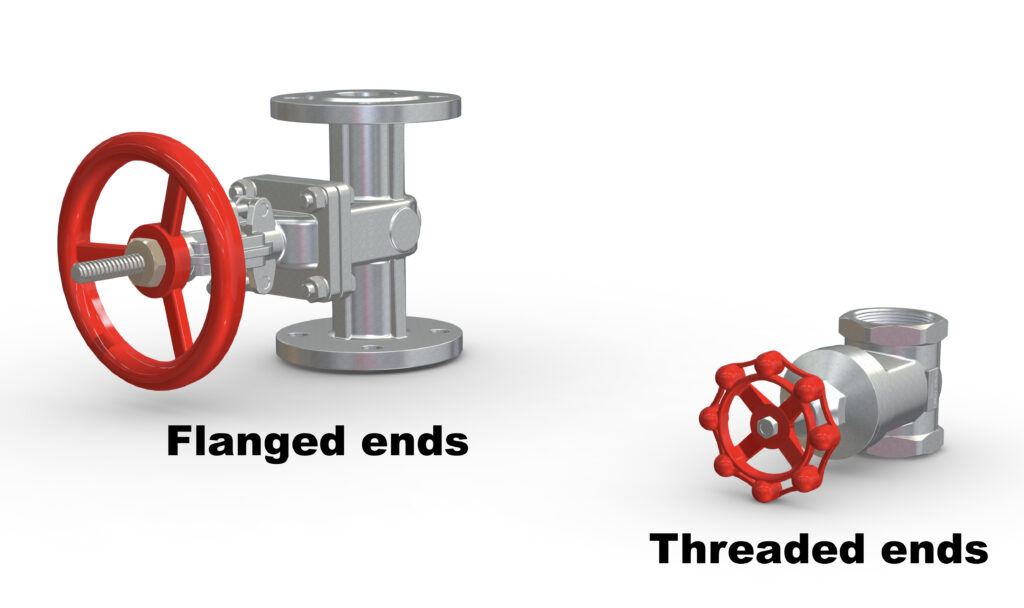A gate valve is a type of valve used to control the flow of liquids and gases in pipes. This type of valve is widely used in industrial applications, including the oil and gas industry, chemical industry and power generation.

Operation of gate valves
A gate valve consists of a metal housing with an opening in the middle. Inside the housing is a movable disc-shaped part, also called a shutter, which can be opened or closed by means of a rotary knob or hand wheel. When the shutter is open, liquids or gases can flow freely through the opening. When the shutter is closed, the passage is closed and the flow of liquids or gases is stopped.
The shutter of a gate valve is usually made of a durable material, such as cast iron, stainless steel or bronze. This ensures that the valve can withstand the pressure and temperature of the liquids or gases flowing through it. In addition, the shutter usually has a sealing mechanism, such as a gasket or O-ring, to prevent liquids or gases from escaping when the shutter is closed.

Advantages and disadvantages of gate valves
There are several advantages to using gate valves in industrial applications. One of the main advantages is the complete opening and closing of the passage. When the shutter of a gate valve is fully open, there is no obstruction to the flow of liquids or gases, ensuring minimum pressure drop and maximum flow rate. In addition, the full closure of the shutter provides a leak-proof seal, which is important when controlling toxic or hazardous substances.
Another advantage of gate valves is their long service life and ease of maintenance. The shutter of a gate valve usually has few moving parts, making the valve less susceptible to wear and failure. In addition, the shutter of a gate valve can be easily replaced if it is damaged, allowing the valve to be operational again quickly.
| Advantages | Disadvantages |
|---|---|
| Complete opening and closing of the passage | Longer operating time compared to other valve types |
| Efficient at high pressure and high temperature | More susceptible to wear and damage |
| Leak-tight seal when closed | Requires a flat, clean sealing surface |
| Few moving parts | More expensive than some other valve types |
| Easy to maintain | Not suitable for fine flow regulation |
| Long service life |
Gate valve 3D 360° View
Applications of gate valves
Gate valves are widely used in various industrial applications due to their reliability and efficiency. Some examples of applications are:
- Oil and Gas Industry: Gate valves are used to control the flow of oil and gas in pipelines. These valves are often used in oil refineries, pipelines and offshore installations where they need to withstand corrosion and high temperatures.
- Chemical industry: Gate valves are used to control the flow of chemicals and other hazardous substances. The leak-proof seal of a gate valve is of great importance to prevent leaks and to guarantee safety.
- Power Industry: Gate valves are used in power stations and other power generating plants to control the flow of steam, water and other fluids. Here too, the leak-proof seal is important to minimize safety risks.
- Water supply: Gate valves are used to control the flow of water in pipes. They are often used in water treatment plants and irrigation systems where they must be resistant to corrosion and wear.
- Maritime Industry: Gate valves are used in shipbuilding and offshore activities to control the flow of seawater and other fluids.

Watch in 3D: click here
Working principle of gate valves (video)
Construction materials of gate valves
| Material | Typical Applications | |
|---|---|---|
| 1 | Cast Iron | Water, air, gas, and some chemicals |
| 2 | Ductile Iron | Water, air, gas, and some chemicals |
| 3 | Carbon Steel | Oil, gas, and some chemicals |
| 4 | Stainless Steel | Chemicals, high temperature, and corrosive fluids |
| 5 | Brass | Water, air, gas, and some chemicals |
| 6 | Bronze | Water, air, gas, and some chemicals |
| 7 | Nickel Alloy | Corrosive fluids and high temperature |
| 8 | Titanium | Corrosive fluids and high temperature |
| 9 | PVC | Water, chemicals, and low pressure |
| 10 | CPVC | Water, chemicals, and low pressure |
International standards for gate valves
| Standard | Description | Countries | |
|---|---|---|---|
| 1 | API 600 | Provides specifications for steel gate valves suitable for use in the oil and gas industry. | United States |
| 2 | API 6D | Provides specifications for pipeline gate valves for the oil and gas industry. | United States |
| 3 | API 602 | Provides specifications for compact steel gate valves suitable for use in the oil and gas industry. | United States |
| 4 | ISO 10434 | Specifies requirements for bolted bonnet steel gate valves for petroleum and natural gas industries. | International Standard |
| 5 | ISO 14313 | Specifies requirements for pipeline transportation systems for the petroleum and natural gas industries. | International Standard |
| 6 | ISO 15761 | Specifies requirements for cast steel gate valves suitable for use in the petroleum, petrochemical and allied industries. | International Standard |
| 7 | ANSI B16.34 | Specifies the requirements for the design, testing, and rating of metal gate valves for various industries. | United States |
| 8 | EN 1984 | Specifies the requirements for resilient-seated gate valves for water supply applications. | European Union |
| 9 | EN 1171 | Specifies the requirements for metal gate valves for water supply and wastewater applications. | European Union |
| 10 | JIS B2061 | Specifies the design and performance requirements for cast iron gate valves for water supply and drainage applications. | Japan |
| 11 | JIS B2071 | Specifies the design and performance requirements for steel gate valves for petroleum, petrochemical, and natural gas industries. | Japan |
Download free gate valve 3D CAD files

Heco.de is a well-known supplier of valves and fittings in the EU. Via their website you can download very good quality 3D CAD models without having to register.